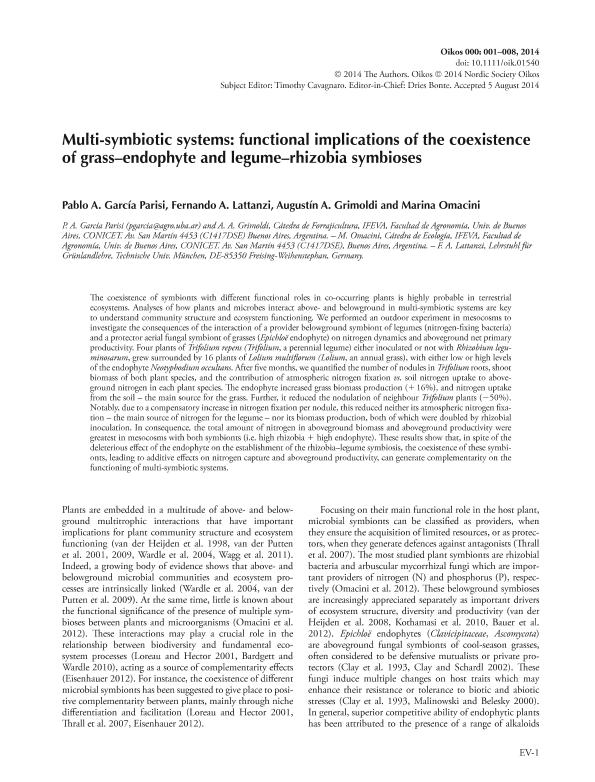Artículo
Multi-symbiotic systems: functional implications of the coexistence of grass-endophyte and legume-rhizobia symbioses
Garcia Parisi, Pablo Adrian ; Lattanzi, Fernando Alfredo; Grimoldi, Agustin Alberto
; Lattanzi, Fernando Alfredo; Grimoldi, Agustin Alberto ; Omacini, Marina
; Omacini, Marina
 ; Lattanzi, Fernando Alfredo; Grimoldi, Agustin Alberto
; Lattanzi, Fernando Alfredo; Grimoldi, Agustin Alberto ; Omacini, Marina
; Omacini, Marina
Fecha de publicación:
10/2014
Editorial:
Wiley
Revista:
Oikos
ISSN:
0030-1299
Idioma:
Inglés
Tipo de recurso:
Artículo publicado
Clasificación temática:
Resumen
The coexistence of symbionts with different functional roles in co-occurring plants is highly probable in terrestrial ecosystems. Analyses of how plants and microbes interact above- and belowground in multi-symbiotic systems are key to understand community structure and ecosystem functioning. We performed an outdoor experiment in mesocosms to investigate the consequences of the interaction of a provider belowground symbiont of legumes (nitrogen-fixing bacteria) and a protector aerial fungal symbiont of grasses (Epichloё endophyte) on nitrogen dynamics and aboveground net primary productivity. Four plants of Trifolium repens (Trifolium, a perennial legume) either inoculated or not with Rhizobium leguminosarum, grew surrounded by 16 plants of Lolium multiflorum (Lolium, an annual grass), with either low or high levels of the endophyte Neotyphodium occultans. After five months, we quantified the number of nodules in Trifolium roots, shoot biomass of both plant species, and the contribution of atmospheric nitrogen fixation vs. soil nitrogen uptake to above ground nitrogen in each plant species. The endophyte increased grass biomass production (+ 16%), and nitrogen uptake from the soil – the main source for the grass. Further, it reduced the nodulation of neighbour Trifolium plants (−50%). Notably, due to a compensatory increase in nitrogen fixation per nodule, this reduced neither its atmospheric nitrogen fixation – the main source of nitrogen for the legume – nor its biomass production, both of which were doubled by rhizobial inoculation. In consequence, the total amount of nitrogen in aboveground biomass and aboveground productivity were greatest in mesocosms with both symbionts (i.e. high rhizobia + high endophyte). These results show that, in spite of the deleterious effect of the endophyte on the establishment of the rhizobia–legume symbiosis, the coexistence of these symbionts, leading to additive effects on nitrogen capture and aboveground productivity, can generate complementarity on the functioning of multi-symbiotic systems.
Archivos asociados
Licencia
Identificadores
Colecciones
Articulos(IFEVA)
Articulos de INST.D/INV.FISIOLOGICAS Y ECO.VINCULADAS A L/AGRIC
Articulos de INST.D/INV.FISIOLOGICAS Y ECO.VINCULADAS A L/AGRIC
Citación
Garcia Parisi, Pablo Adrian; Lattanzi, Fernando Alfredo; Grimoldi, Agustin Alberto; Omacini, Marina; Multi-symbiotic systems: functional implications of the coexistence of grass-endophyte and legume-rhizobia symbioses; Wiley; Oikos; 124; 5; 10-2014; 553-560
Compartir
Altmétricas



